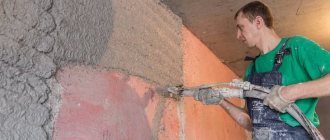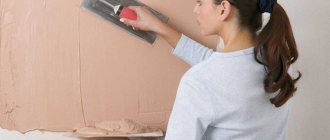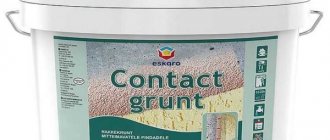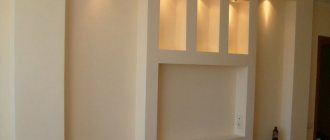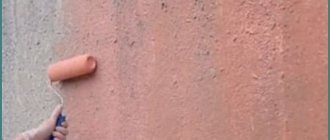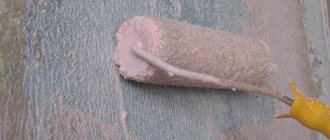It would seem that what could be easier than understanding the principle of operation of a concrete contact and using it according to the instructions? Bought it, mixed it, applied it, and then do whatever you want: plaster, tile, apply any finish. However, practice shows that in reality everything is not so rosy. Repairs using concrete contact soils sometimes turn into real torture. In this article we will tell you which surfaces need the use of concrete contacts, and where you can do without it. We’ll also talk about the cost and economical application of this type of primer.
Specifications
Let's look at what concrete contact is and why it is needed. A popular primer is supplied by almost every manufacturer of paints and varnishes or leveling mixtures. The developers of the composition are recognized as German technologists from the family enterprise Feidal. In the original version, the pink liquid mass is represented by 40-50% solid/dry matter, the rest binding with functional additives.
The technical characteristics of concrete contact are determined by three groups of components:
- acrylic dispersion is responsible for adhesion indicators;
- quartz sand or analogues provide roughness;
- functional additives that give the coating water resistance, resistance to biological or corrosive damage.
Healthy soil has a neutral acidity level. This explains the absence of chemical reactions between the coating and any plaster/adhesive solutions based on a mineral binder, for which concrete contact is more often used.
Mechanical plastering of walls using concrete contact Source specteh-rzn.speczakaz.info
The consumption of primer material directly depends on the size of the solid filler. So, for the most part, the fraction of grains or crystals is 0.3-0.6 mm. The lower the indicator, the less composition will be needed to treat a given area. The dependence also lies in the processed base:
- high-density monolithic/slab concrete – from 350 grams per sq.m;
- tiles, porcelain stoneware – about 150-250 grams/sq.m;
- oil/alkyd paint with continuous coating – at least 200 grams.
To make it easier to monitor the solidity of the coating, manufacturers add pigment additives to the soil. Pink color predominates, blue is less common. The Tex company has found a more original solution - as the composition dries, it begins to turn red on the surface.
How to buy concrete contact and not go broke on construction
Not a single professional will advise saving on priming surfaces with concrete contact. In order for the plaster, glue or topcoat to last long and firmly, the layer of such primer must be applied evenly, without gaps and have sufficient thickness. The greater the thickness of the concrete contact layer, the better its adhesive properties are manifested. There is no point in saving here - you can lose much more by spoiling, for example, not cheap drywall, tiles and other materials that have fallen off.
The sufficiency of the thickness of the covering concrete contact is determined simply: you need to run any spatula over the dried surface, and if the sand particles crumble, you need to apply another layer.
The cost of concrete contacts on the Russian market varies greatly, so the average price will not make much sense.
You can buy high-quality concrete contacts much cheaper from domestic manufacturers, especially since high cost does not always mean better quality. Often the price of concrete contact per 1 m2 is no more than 10 - 20 rubles (one-time coating).
Attention! Due to the fact that there are often counterfeits of the product or failure to comply with storage standards, an important question is: where to buy concrete contact? The answer is only from reliable suppliers, in specialized stores with stable temperatures, or through the manufacturer’s website.
Based on the consumption rates, it turns out that a 10-liter can of concrete contact is enough to cover 20 - 50 square meters. meters of surface.
If you also take into account the service life of the coating, it turns out that it is not that expensive.
Purpose
The scope of application of the soil lies in the information about what it is - concrete contact. The acrylic binder has the ability to penetrate deeply. The composition forms a vapor-permeable rough film. Such properties are valued when working with substrates that do not absorb moisture and have a smooth surface. A common option of this type is concrete.
Smooth concrete floor Source yandex.net
The high adhesive ability of the soil ensures a strong connection of materials. To tear off the coating you will need to apply an average force of 100 g/sq.mm. This suggests that the base treated with concrete contact will be able to withstand a large layer of leveling plaster and cladding.
Among other things, due to the filler and the properties of the acrylic component, the dry residue can strengthen the base. The film has a high tensile strength. This is especially true when finishing an old base with microcracks.
As a result, the scope of application of concrete contact extends to the treatment of surfaces of the following nature:
- high-density concrete (panel houses, columns);
- ceramic tiles for finishing without dismantling the coating (two-layer application of primer is recommended);
- dry wooden base to be plastered (other compositions are not suitable);
- metal structures for any purpose without pre-treatment with an anti-corrosion compound;
- plastic or glass surface with correct calculation of the weight load of subsequent finishing.
Priming a painted surface Source snappygoat.com
See also: Catalog of companies that specialize in finishing materials.
Separately, a primer with sand is considered for suitability for brickwork. Not all manufacturers include such a base in their scope of application. The reason is the heterogeneity of ceramic blocks and grout. The latter refers to porous materials that are rarely permissible to be covered with concrete contact.
Acrylic-based compositions can be diluted with water if necessary (not recommended). After drying, the coating can be painted with dispersion paints. Often the surface is decorated using concrete contact. If the composition is not stirred until smooth, then using a brush you can form a chaotic pattern. This way, you don’t have to align the walls with the ceilings, but you can visually transform it for a long time, and additionally protect it from fungus, mold, and corrosion.
Often in the old foundation, finishers are faced with oil paint and chalk. Such finishing is subject to maximum elimination. Next, you should make notches under the plaster or cladding using an ax or a hammer with a chisel, and sand the surface with a coarse abrasive to create roughness.
Notches on a complex base Source couo.ru
After removing grease stains and dust, priming can be carried out, preferably in two layers with intermediate drying.
Among the recommendations you can find the use of contact concrete under putty. However, this material is intended for thin layer application and finishing. The sand contained in the soil will contribute to the formation of scratches and, in general, the composition will be a waste of time, effort, and money. For final leveling, it is enough to treat the base with a dust-removing agent for plaster, a highly specialized primer for metal, plastic, and glass.
Restrictions on use
Most manufacturers and consultants on trading platforms position concrete contact as a universal material. This applies to any soil regarding the nature of the finish with the base, but not suitability for work indoors and outdoors. Samples applicable in both directions exist, but their number is limited. In fact, some soils cannot be used for treating the facade, roof, or basement.
Primer for interior work Source stpulscen.ru
Some options are only permissible for substrates in dry rooms. It is important to first read the instructions on the labels of the cans or buckets.
Due to the high strength of the film, soil is often used to strengthen a loose foundation, for which concrete contact is unsuitable. The composition will penetrate into pores and microcracks, but only superficially. As a result, the finish may fall off the wall or ceiling in a layer under its own weight. Here you need a special strengthening agent with deep penetration.
In order to enhance adhesion and reduce absorbency, any porous substrates must be treated. Soil with quartz sand is not suitable for this, since the binder component will mostly end up in the pores. As a result, the permeability of the breathable surface will decrease to an insignificant extent, and the bond between the filler grains will be insufficient to withstand the declared mechanical load. The solution here is an impregnating agent, which is applied in 2-4 layers with intermediate drying.
Porous materials Source prom.st
Is concrete contact necessary over oil paint?
Some people may use concrete contact on surfaces that have been coated with oil-based paint. Most experts still advise removing the paint before processing, because the primer layer may fall off due to its own weight.
If the paint cannot be removed by any means, then you should follow these simple steps.
- Thoroughly degrease the entire surface without skipping even small areas.
- With the help of abrasive processing (sandpaper or a special metal brush), all irregularities are eliminated, as well as the smoothness of the surface.
- Notches are made using a chisel or an ax.
- Then dirt and dust are removed. You can even do this with a vacuum cleaner. The main thing is quality.
- Next, the first layer of concrete contact is applied. You need to wait until it is completely dry and then apply another layer.
- When the second layer is completely dry, you can begin further processing of the surface and begin laying tiles, puttying or plastering.
If all actions are performed correctly and efficiently, the result will really please you, and the quality of the finish will be incredibly high
.
If errors are made during the execution of the work, then in the future this may cause a deterioration in the quality of the repair and the appearance of various types of defects.
Concrete contact is an indispensable material for those people who want to get really high-quality repairs and not worry about the condition of the walls and ceiling for a long time.
Video description
From the video you can get acquainted with the features of various primers:
There are points for which concrete contact is needed, but with limitations. This applies to metal, wood, plastic and glass. The expected result will be obtained only on a mineral surface with the listed inclusions. For a solid base, the option of subsequent finishing with light weight using paints and varnishes would be relevant.
Experts note deviations from the expected when concrete contact is used under self-leveling floors. If you have to work with cement mortar, the adhesion is good, but gypsum does not spread. As a result, cracks and peeling of the coating appear.
Concrete contact for interior work: features and properties
Inside the building, concrete contact is applied as a primer for any surfaces:
- To prepare the ceiling for whitewashing.
- For floors - under any screeds, including self-leveling floors. Thanks to increased adhesion, you can make a screed without removing the old, durable tiles. Concrete contact is the best treatment before gluing linoleum.
- Before covering any walls and partitions with plaster, putty and any other finishing materials.
- To strengthen drywall - reduces its porosity, gives it water resistance, allows you to apply any paint to drywall, glue wallpaper and facing tiles.
For all surfaces to which concrete contact is applied, drying takes an average of 2-3 hours - this is very fast compared to other soils.
What also speeds up the renovation process is that it can be applied to old finishes: paint, gypsum plaster and even tiles. But provided that this finish is very durable. Otherwise, the unreliable layer must be knocked down.
Is it possible to apply concrete contact to the paint before puttying?
Concrete contact works great in rooms with high humidity and steam formation: in the bathroom, kitchen, basement, laundry room, etc.
Attention! Concrete contact that accidentally gets on the skin can be easily washed off with water. But only until it dries. Therefore, all stains from it must be removed immediately.
If you are interested in checking out quality products on the topic of this article, we suggest you follow the link
View all products in the category
Errors at work
Due to inexperience or ignorance, building materials for intermediate installation are often used, making mistakes. The consequences of this can be unpredictable, and it is almost impossible to track the processes of destruction under finishing in a timely manner. This also applies to concrete contact.
Consequences of violating plastering technology Source kontrolstroy.ru
In reviews, there is often a remark about adhesives and leveling mixtures that they have poor adhesion to soil with quartz. This is only possible if the solution contains an excess amount of water. This drawback leads to the separation of mixtures due to a disrupted moisture transfer process and a low concentration of the binder component.
Deviations from the declared soil parameters may occur for the following reasons:
- applying the composition at temperatures below +7 – +10°C or above +25°C, at a relative air humidity above 65%;
- processing frozen or wet bases;
- finishing of an unprepared surface (dust, grease stains, affected areas, weak spots);
- inadequate drying of the coating (how long the concrete contact dries depends on the recipe, the original takes only 3-4 hours);
- wind or draft accelerates the process of water loss and the formation of dry residue, but disrupts its quality;
- adding water reduces the concentration of the binder and deteriorates the quality of the adhesive film;
- use of cheap analogues of Betokontakt for “heavy” finishing.
“Heavy” wall cladding with porcelain stoneware Source otdelkino.ru
Dust can be invisible, but it actively sticks to the primed surface. The plaster and glue will peel off from such a base. You will have to do the pre-treatment again.
The solid filler is heavier than the other components in concrete contact. It settles relatively quickly to the bottom of any working container. Therefore, it is important to stir the composition periodically.
The original soil is stored in an airtight container for only 2 years, analogues from six months. Mostly natural ingredients will most likely not cause any harm to health after the expiration date. But quality indicators will noticeably decrease. After sub-zero temperatures during storage, it will be possible to work only with frost-resistant soil. But in any case, it is applied at temperatures above +7 – +10°C to +25°C. This applies to the material, the base and the air.
For priming smooth, non-absorbent surfaces there is no alternative to concrete contact.
To prepare for finishing loose, crumbling, porous surfaces, it is necessary to strengthen them by impregnating them to a certain depth, which requires deep penetration soil. It can be used independently or before concrete contact. If you use only concrete contact, the consumption may turn out to be exorbitant.
Is it possible to apply concrete contact to drywall?
Complex application or just a primer or concrete contact - which is better must be decided taking into account all the specific conditions separately for each case.
Concrete contact for external work: features and properties
According to their purpose, concrete contacts are:
- for interior work;
- combined - for internal and external.
Specialized compositions only for external use are not yet available. For this purpose, concrete contact is used, the instructions of which directly indicate the possibility of its use for priming the surfaces of the facade or foundation of a building for putty or plaster. At the same time, all the characteristics that determine concrete contact remain unchanged.
Is it possible to apply concrete contact to whitewash?
There is some disagreement about whether concrete contact should be used under cement plaster. Or why use it for foam blocks - after all, their surface is initially quite rough, and the structure is such that it requires a deep penetration primer more.
More often, for outdoor surfaces, soils containing coarse-grained fractions of quartz sand are used (expanded clay, marble, etc. chips are also successfully used), capable of holding heavy plaster.
When planning plastering and facing work on the outside using fastening layers of concrete contact, you need to remember that it only works at positive temperatures. When the temperature rises to more than 30 degrees (40 degrees for some brands), the properties deteriorate significantly - the uniformity of drying is disrupted. At temperatures below +5 degrees, concrete contact gradually turns into a viscous sticky mass that is impossible to work with (if the “frost-resistant” property is indicated, then it refers to storage conditions).
Is it possible to apply concrete contact to putty?
But when finished, treated with concrete contact and dried (concrete contact dries very quickly), any surface retains its properties in a wide range of temperatures and under any external atmospheric influence. Therefore, it is used with great success for the conservation of facades - when finishing work has to be suspended, for example, for the winter.
The price for universal concrete contact is not too different from the price for concrete contact for interior work.
Application Tools
The choice of one or another painting tool depends on several points. The main ones are the nature of the building material, the shape, composition and structure of the base, ease of use. Concrete contact is a liquid mass, similar in consistency to kefir, but sometimes a little thicker.
Priming a flat surface with a paint roller Source eyecorrector.ru
A spray gun is also not suitable here because of the hard grain filler.
Since the composition of the concrete contact primer does not include organic solvents, acids, alkalis, or other aggressive components, it is permissible to use tools with any bristles and fur coats by nature. But there are still restrictions.
Soft materials quickly become unusable due to sand. Flat brushes do not pick up much thick mass and do not distribute the filler well over the base. It is more rational to use brushes with hard or medium-hard bristles. In general, it is more difficult to work with a roller for three reasons:
- the grain component is unevenly distributed on the surface;
- solid particles actively scatter over the area depending on the speed of rotation of the roller;
- Short pile and fur take up little soil, while long pile significantly weighs down the tool and splashes more.
As a result, the soil and concrete contact with minimal losses and maximum quality will be applied using a brush with synthetic or mixed bristles.
Distribution of betocontact with maklovitsa Source gidpokraske.ru
In terms of length, it is better to choose medium. It is noticeably easier and faster to work with a roller, but the consumption of the applied acrylic composition will increase, the solid filler will be unevenly distributed, and a lot of debris and splashes will form.
During priming, it is important to protect the skin from betocontact. The same goes for clothes and shoes, if they are not work shoes. Before drying, the composition is easily washed off and washed off. But the splashes and droplets begin to harden after just a few minutes.
After drying, the primer will be very difficult to remove due to its high adhesive ability. The fabric will have to be cut and scraped, but damage cannot be completely avoided. Concrete contact can be removed from the hairline only together with the hair. A rich cream or oil can make the task easier and reduce trauma.
Concrete contact primer from different manufacturers
There are not many manufacturers of concrete contacts in the world that produce high-quality products. Each of them has its own characteristics and production secrets.
The most famous is the Knauf company. Knauf Betokontakt concrete contacts with fine-grained and coarse-grained fillers are successfully used in a variety of areas and are very popular among consumers.
Is it possible to apply concrete contact over paint?
Another oldest world-famous manufacturer is Ceresit. The universal concrete contact Ceresit CT 19, in addition to other useful qualities, is distinguished by its particularly effective use for tile-to-tile facing technology.
The European leader is the Feidal concern and, in particular, it produces Feidal Super Kontakt concrete contact for combined use, which has proven itself indispensable for the renovation of old houses with many coatings of drying oil and oil paint.
If there is a need or desire to carry out finishing work in a short time, then it would be correct to use concrete contacts with latex additives, which are characterized by particularly fast drying within 50-60 minutes.
Is it possible to apply concrete contact to wood?
Concrete contact can be produced not only as a ready-made solution, but also in dry form. Thus, the dry concrete contact mixture “Axton” for universal use with marble chips instead of quartz sand has technical characteristics no worse than those of liquid soils. Its operational technological feature is the ability to be used on unpolished and uncleaned surfaces.
The quality and reliability of concrete contacts is a privilege not only of well-known brands and historical enterprises. There are modern manufacturers that successfully master innovative technologies and produce high-quality products that meet international standards and GOST requirements in all respects.
GOODHIM GBK concrete contact primer has all the technical characteristics of high-quality concrete contact soil: it reliably binds a variety of finishing materials to a hard surface, provides waterproofing, retains its properties for 30 years, etc. At the same time, it has a very important property - an increased shelf life - 24 months, which is twice as long as its analogues!
Is it possible to apply concrete contact over oil paint?
Depending on taste and financial capabilities, everyone must decide for themselves which concrete contact company is better to choose.
Popular manufacturers
With the use of concrete contact primer, we’ve figured out its basic characteristics, and let’s get acquainted with the distinctive features of compositions from different manufacturers.
Knauf brand soil Source stpulscen.ru
Let’s take the original version of Betokontakt as an example: it dries in 3-4 hours, the consistency is a little thick, the condition is viscous, the filler is fine-grained. Below we consider individual properties of analogues:
- Bolars is too thick, difficult to work with, takes more than a day to dry;
- Olympus - expensive, but not inferior to the original composition;
- Osnovit (Bettokont) - sand settles quickly, dries in up to 2 hours, the manufacturer limits its use only for gypsum solutions;
- Plitonite – the filler is lightweight, so it settles slowly and does not require frequent mixing;
- Pufas – marked by lower adhesion to concrete against the background of Betokontakt;
- Prospectors - dries up to 4 hours, the sand fraction is coarse, which is important for rough leveling finishing and heavy cladding;
- Ceresite is the most common object for counterfeiting.
The German brand Knauf produces relatively inexpensive soil. It has low moisture resistance, so applying liquid solutions is not recommended. In contrast, they put a moisture-resistant sample with marble chips under the Shtock brand.
Akrimax-Lux brand soil Source storg.ru
Briefly about the main thing
Betokontakt is made from acrylic dispersion, fine-grained solid filler, and functional additives.
Almost all manufacturers add pigment additives to the composition to monitor the consistency of the coating.
The main task of the primer is to create good adhesion of solutions with smooth and dense concrete. Additionally, such substrates as ceramic cladding, brickwork, and oil paint are considered. Such surfaces are not always included in the list of acceptable ones for a particular brand of soil.
In the recommendations, you must find out information about the possible use of the material outside and in wet rooms, since not all options are universal.
Ratings 0
Instructions for using concrete contact
Working with polymer-sand primer for smooth surfaces is easy. For manual work you will need:
- ready-made concrete contact solution or dry mixture for self-preparation;
- roller with a long handle for covering walls or floors;
- wide brush for working corners;
- tray for rolling out the solution.
For faster work, the only tools you need are a spray gun.
Stage 1: preparation
For new surfaces, removing traces of formwork and degreasing is sufficient if lubricants were used to remove the form. It is also necessary to get rid of traces of bitumen and dust deposits.
To work with indoor concrete contact, it is necessary to create optimal temperature conditions of +5°...+30°C according to the instructions. However, it is recommended to coat the walls at a temperature of about 20° - this way the solution adheres better and does not set prematurely in the tray and on the brush (roller). The room should be well ventilated to normalize the humidity level.
Stage 2: application
How to apply concrete contact with a brush and roller:
- they start working from the corners - they are painted over with a brush in the same way as with paint;
- It is convenient to cover the main area with a roller, dipping it into a tray with primer, rolling out the remains on the grate and applying the product to the walls.
When applying manually, the solution in the bucket must be stirred periodically - grains of sand settle at the bottom of the container.
Before loading the concrete contact into the spray gun, it is necessary to add 0.05 liters of water per 1 kg of soil to obtain a working consistency. The emulsion should be applied at a time, continuously covering the entire wall, floor or ceiling.
